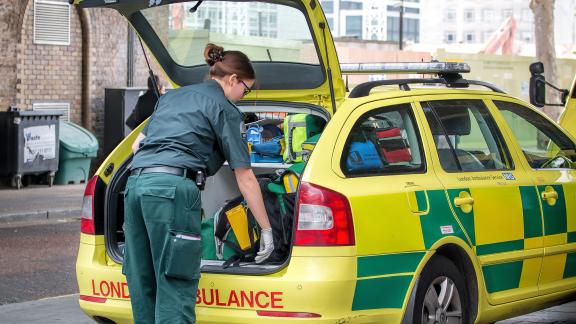Urgent and emergency care clinical review of standards

NHS England and NHS Improvement (NHSEI) has published Transformation of Urgent and Emergency Care: Models of Care and Measurement which sets out the final recommendations on the urgent and emergency care standards from the Clinically-led Review of NHS Standards.
The proposed new standards seek to ‘drive the next step change in improvements in patient care and experience, while helping to maintain COVID-19-secure ways of working’. The report also announces the opportunity for patients, clinicians and the public to respond to these findings in a consultation.
NHS Clinical Commissioners, on behalf of the NHS Confederation, was involved in the oversight group that supported the development of these indicators.
This briefing provides a summary of some of the most relevant points to our members and gives our viewpoint on the proposals.
Key points
-
The consultation sets out how the proposed changes to measuring urgent and emergency care activity will align to the NHS Long Term Plan programme to transform urgent and emergency care for patients.
- The review of the access standards in urgent and emergency care highlighted some of the key issues with the current four-hour target standard, including that is not well understood by the public, only measures a single point in the patient pathway and doe not take into account total waiting times. It also does not differentiate between severity of condition.
- The review proposes a new set of standards for urgent and emergency care which provide a more nuanced way of assessing performance and aims to support improvements in care by changing the way the system is both perceived and accessed by the patient.
- The recommendation of the Clinically-led Review of NHS Standards is that the existing four-hour standard should not be part of the new bundle of standards. The four-hour target focuses on only one part of the system and does not provide enough detail on the happenings within the urgent and emergency care system.
- The new standards proposed in the document focus on four key principles:
- Ensuring people with urgent care needs get the right advice in the right place, first time.
- Providing highly responsive, bookable, urgent care services that support reduced avoidable attendance at, or time in, an emergency department, and resultant admissions.
- Ensuring that those people with more serious or life-threatening emergency care needs receive treatment in centres with the right facilities and expertise in order to maximise chances of survival and a good recovery.
- Ensuring that no patient stays in the emergency department or in hospital longer than is clinically necessary.
- While useful for some aspects of urgent and emergency care, the proposed standards do not speak to the full system and need to be developed to encompass primary and community care, mental health and social care.
- Our members need sufficient resources and support from national and local leadership to meet the aspirations of the standards.
Transforming access to urgent and emergency care services
The COVID-19 pandemic has had a profound effect on the delivery of NHS services and the way the general public access healthcare, and urgent and emergency care services in particular.
Through the pandemic, we saw rapid development of NHS 111 as well as an increase in the number of people accessing the service. The development of NHS 111 provides a safe and convenient way for the public to access urgent care and reduces some of the pressures in emergency departments. It also allows for infection control measures, including social distancing, to be adhered to.
The proposal aims to develop NHS 111 through:
- investment in NHS 111 call handling capacity to increase the volume of calls that can be managed
- investment in clinical capacity within local clinical assessment services
- development of processes and IT enablers to appropriately stream low acuity unheralded patients to alternative non-emergency department settings.
We welcome the proposal to develop NHS 111 and the further £40 million that will be made available to help this be developed. The improvement of NHS 111 will have a much-needed improvement in access to urgent and emergency care. However, with an increased use of 111, it important for the public and wider healthcare profession to have assurance in the standard of advice they will receive through 111.
Improving flow through hospitals: emergency departments and same-day emergency care
Improving patient flow into, through and out of emergency department is critical to improve both patient care and patient experience. To improve the flow through hospitals, the following indicators have been proposed to include in measures:
- hospital handover delays
- time to initial assessment
- mean time in department for non-admitted patients
- percentage of patients spending more than 12 hours in A&E.
While we welcome the proposed indicators, it is important to acknowledge the fundamental reasons behind the delays in hospital flow, which is ultimately due to lack of resources, including staff. Both ambulance and hospital staff need to be supported to work through these indicators.
999 ambulance services: optimising performance and reducing wider service pressures
Improving ambulance performance and providing a clinically appropriate response for patients are the key drivers for ambulance services. In 2017, a new operating model was introduced which ensures that the sickest patients get the fastest response and that all patients get the right response first time.
The current access standards in urgent and emergency care for all ambulance trusts is to:
- respond to category 1 calls in 7 minutes on average, and respond to 90 per cent of category 1 calls in 15 minutes
- respond to category 2 calls in 18 minutes on average, and respond to 90 per cent of category 2 calls in 40 minutes
- respond to 90 per cent of category 3 calls in 120 minutes
- respond to 90 per cent of category 4 calls in 180 minutes.
The new standards propose two indicators instead of these to measure the efficiency of pre-hospital responses.
- 999 category 2 response time, responding to 90 per cent of category 2 calls in 40 minutes
- conveyance rates to emergency departments by 999 ambulances.
The NHS trial found that it is more important to look at category 2 response times which are for emergency calls, such as stroke patients, and looks at a broader amount of people than category 1 response times, which are for life-threatening injuries and illnesses.
We welcome the new standards, especially the aim to reduce avoidable conveyance to emergency departments, as this will help reduce avoidable attendances at emergency departments, and in turn patient flow, as well reduce nosocomial transmission risk.
Discharge and community response
The new proposal sets out plans to measure indicators that will monitor the flow of patients through the hospital system and back into the community. Good patient flow is critical to improving care for patients and will reduce the demand on acute beds.
The proposal sets out three indicators to be measured:
- mean time in department for admitted patients
- clinically ready to proceed from the emergency department versus when they actually leave
- percentage of patients spending more than 12 hours in A&E.
In addition to the three new indicators, average length of stay has been used for several years as an important operational driver of overall hospital occupancy, and it will continue to be monitored.
We welcome the proposed indicators as helping ensure that no patient stays in the emergency department or in hospital longer than is clinically necessary. However, in order for this standard to be achieved, it requires joint working across the system, including both community and social care.
At a glance: proposed new bundle of standards by the Clinically-led Review of Standards
|
Service |
Measure |
|
Pre-hospital |
Response times for ambulances |
|
A&E |
Percentage of ambulance handovers within 15 minutes |
|
Hospital |
Average (mean) time in department - admitted patients |
|
Whole system |
Patients spending more than 12 hours in A&E |
NHS Confederation viewpoint
We will consider the details of the proposals with our members, but this feels like significant progress towards improving services by setting a more thoughtful way of ensuring accountability for the care we provide to those seeking urgent and emergency care.
Our members are, of course, interested in how the standards will be translated into practice and how NHS England and NHS Improvement will adapt its routine oversight in response. Also, they need to understand how the standards can continue to be developed to be truly system-wide, particularly as the importance of the role of primary and community services to provide alternatives to hospital admission and support timely transfers of care cannot be overstated.
The ability of the NHS to meet these new standards needs thorough support from the government; currently, the resources and people are not in place to match the aspirations that will rightly be set as a result of this work. The Chancellor did not feel able to address this issue in November; he must not fail to do so again.



